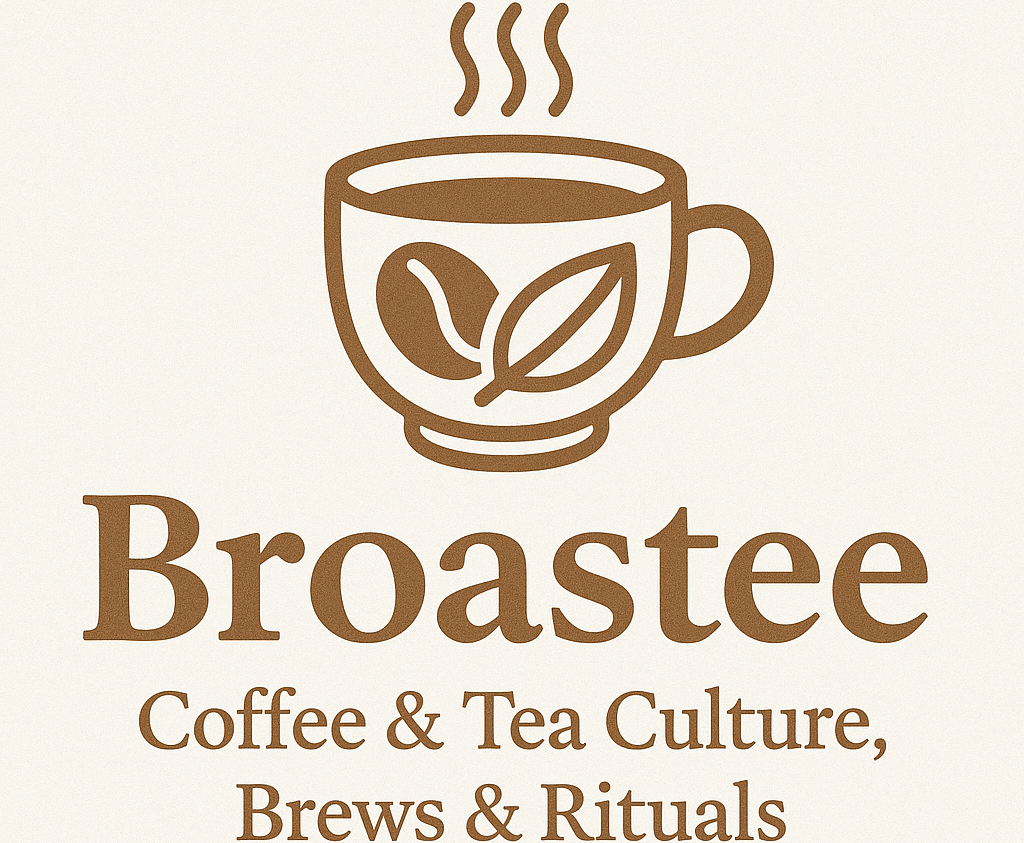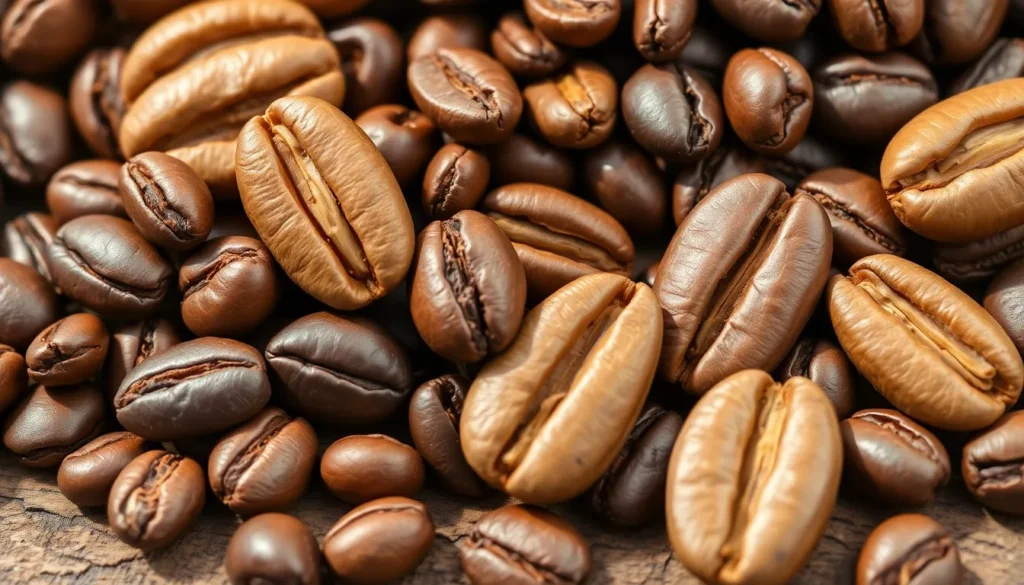When we think about our morning coffee ritual, we rarely consider the incredible journey that begins with a single bean. Yet understanding the different types of coffee beans can transform your daily cup from ordinary to extraordinary. The industry of coffee offers far more variety than most people realize, and knowing these distinctions will help you make better brewing decisions.
We’re about to explore the fascinating universe of coffee beans that shape every sip you take. From the smooth and sweet Arabica to the bold and robust Robusta, each variety brings its own unique flavor profile and characteristics. These differences aren’t just academic—they directly impact the taste, aroma, and quality of your coffee.
Whether you’re a casual coffee drinker or an aspiring connoisseur, we’ll guide you through everything you need to know about coffee bean varieties. You’ll discover how origin, processing methods, and bean types work together to create the perfect cup that matches your taste preferences.
Arabica Coffee Beans: The Premium Choice for Coffee Connoisseurs
Arabica coffee beans represent approximately 60-70% of global coffee production and consistently deliver the refined taste that discerning coffee lovers seek. We’ll explore why these premium beans command higher prices and greater respect among coffee enthusiasts worldwide.
Origins and Growing Regions
Ethiopia stands as the birthplace of Arabica coffee, where wild coffee plants still grow naturally in the mountainous regions. We trace the origins of these exceptional beans back thousands of years to the Ethiopian highlands, specifically the Kaffa region.
Central and South America produce the majority of today’s Arabica coffee supply. Countries like Colombia, Brazil, Costa Rica, and Guatemala have established themselves as premier growing regions due to their ideal climate conditions and elevation ranges between 2,000 to 6,000 feet above sea level.
African nations continue to cultivate some of the industry’s most prized Arabica varieties. Kenya, Tanzania, and Yemen produce beans with distinctive flavor profiles that coffee connoisseurs actively seek out for their unique characteristics.
Asian growing regions contribute exceptional Arabica beans from countries like Jamaica (Blue Mountain), Hawaii (Kona), and parts of Indonesia. These regions benefit from volcanic soil and exact microclimates that enhance the beans’ natural flavor development.
Flavor Profile and Characteristics
Arabica beans deliver a smoother, more complex flavor profile compared to their Robusta counterparts. We notice distinct notes ranging from fruity and floral to nutty and chocolatey, depending on the exact variety and processing method.
Acidity levels in Arabica coffee create bright, clean flavors that many coffee enthusiasts prefer. This natural acidity contributes to the wine-like qualities found in high-grade Arabica varieties, particularly those grown at higher elevations.
Sugar content in Arabica beans reaches nearly twice that of Robusta beans. We observe this higher sugar concentration translating into naturally sweeter flavors and more caramelized notes during the roasting process.
Caffeine content in Arabica beans remains lower than Robusta varieties, typically containing 1.2-1.5% caffeine compared to Robusta’s 2.2-2.7%. This lower caffeine level contributes to the smoother, less bitter taste profile that characterizes premium Arabica coffee.
Popular Arabica Varieties
Typica represents one of the oldest and most genetically important Arabica varieties. We recognize this variety as the foundation for many other Arabica cultivars, originally brought from Ethiopia to Yemen and then spread globally through trade routes.
Bourbon varieties produce exceptionally sweet and complex flavors that coffee cupping experts consistently rate highly. These beans, originally cultivated on the island of Bourbon (now Réunion), thrive in high-altitude growing conditions.
Geisha (or Gesha) coffee commands some of the highest prices in specialty coffee auctions. We’ve seen these beans, originally from Ethiopia but famously cultivated in Panama, sell for over $1,000 per pound due to their extraordinary floral and tea-like characteristics.
Caturra offers a compact plant size with excellent flavor potential for commercial cultivation. This natural mutation of Bourbon produces bright, clean cups with good acidity and is widely grown throughout Central and South America.
SL28 and SL34 varieties from Kenya produce the distinctive black currant flavors that define Kenyan coffee. We identify these cultivars as products of selective breeding programs that emphasized both quality and disease resistance in the early 20th century.
Robusta Coffee Beans: The Bold and Caffeinated Option

While Arabica beans dominate the specialty coffee market, Robusta coffee beans represent the second major species of coffee that packs a powerful punch. These robust beans offer unique characteristics that make them essential for exact coffee applications and perfect for those seeking an extra energy boost.
Higher Caffeine Content Benefits
Robusta beans deliver nearly twice as much caffeine as their Arabica counterparts, making them the go-to choice for coffee drinkers who need maximum energy. The elevated caffeine levels in Robusta provide a more pronounced energy boost that’s particularly ideal for morning consumption when we need that extra kick to start our day.
Beyond the energy factor, this higher caffeine content also acts as a natural pest deterrent for the coffee plants themselves. Caffeine serves as the plant’s built-in defense mechanism, which explains why Robusta plants are generally hardier and easier to cultivate than Arabica varieties.
Bitter Flavor Notes and Texture
Robusta coffee presents a distinctly bold flavor profile characterized by strong, bitter taste notes with earthy undertones. We often detect notes of burnt wood and earth in Robusta beans, creating a robust flavor that stands up well in milk-based drinks and espresso preparations.
The texture of Robusta coffee contributes significantly to espresso quality, as these beans produce superior crema compared to Arabica beans. This enhanced crema formation results in a smoother, more full-bodied texture that baristas value for creating visually appealing and texturally satisfying espresso shots.
Commercial Uses and Applications
Robusta’s practical applications extend far beyond standard brewing methods, with espresso blends being one of its primary commercial uses. The robust flavor profile and superior crema production make Robusta an essential component in many espresso-based drinks served in cafes worldwide.
Instant coffee manufacturers heavily rely on Robusta beans due to their strong flavor that withstands the processing required for instant coffee production. The beans’ intense taste ensures that the final instant coffee product maintains adequate flavor strength after dehydration and packaging.
Outdoor enthusiasts and campers particularly appreciate Robusta coffee for its ease of brewing and bold flavor that cuts through the challenges of outdoor preparation. The forgiving nature of these beans means they maintain their robust character even when brewing conditions aren’t perfect, making them ideal for camping trips and outdoor adventures.
Liberica Coffee Beans: The Rare and Exotic Alternative
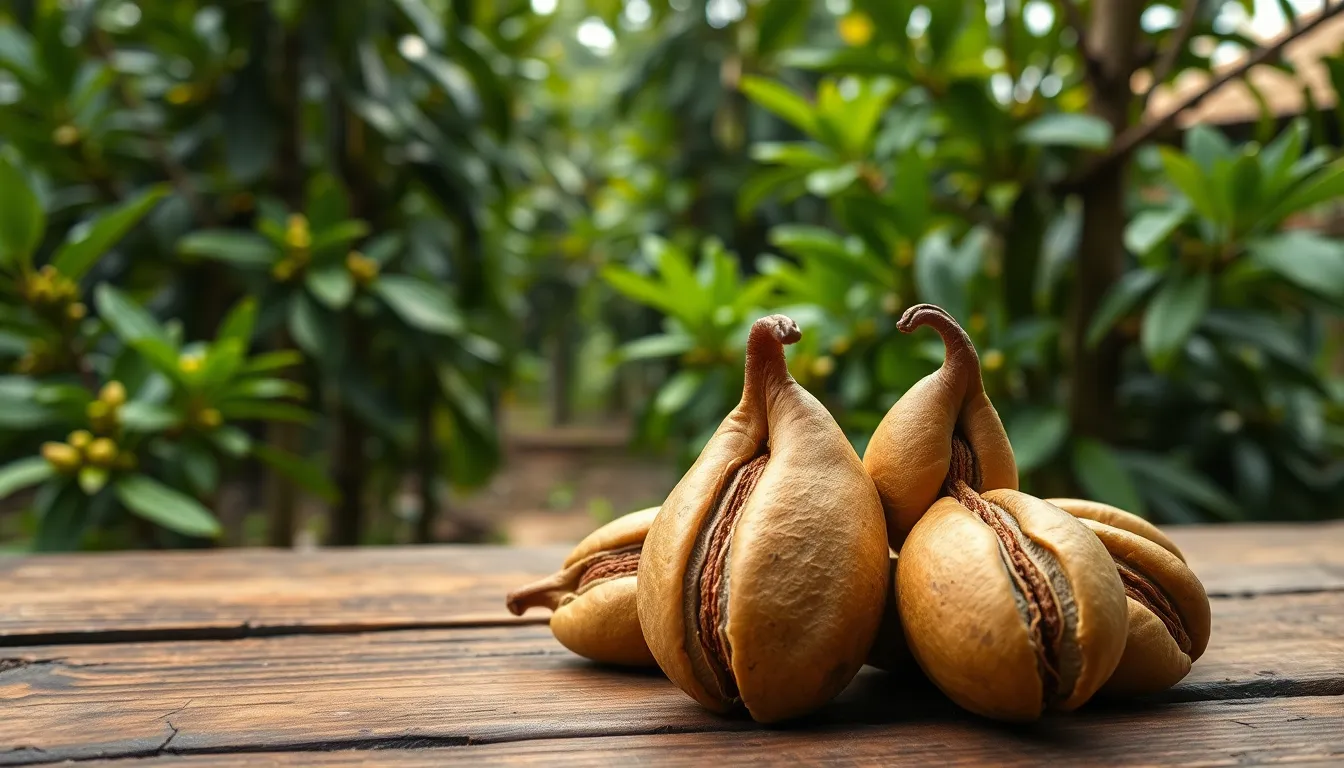
Beyond the familiar Arabica and Robusta varieties lies a fascinating third species that coffee enthusiasts rarely encounter. We’re exploring Liberica coffee beans, a unique variety that offers coffee lovers an entirely different experience from conventional options.
Unique Large Bean Size
Liberica beans stand out immediately due to their impressive size compared to their more common counterparts. We can easily distinguish these beans from Arabica and Robusta varieties because they’re significantly larger in every dimension. The beans feature a distinctive teardrop shape with an asymmetrical structure that makes them unmistakable.
Each Liberica bean displays a characteristic “hook” at the tip and a jagged central furrow running through the middle. Trees producing these oversized beans can reach heights of up to 20 meters, towering over other coffee plants. The cherries themselves are proportionally larger, as are the leaves, creating an impressive visual distinction from standard coffee plants.
Processing reveals beans that range from yellowish to lemon-yellow or even light green when handled correctly. We find that this size difference isn’t just cosmetic—it reflects the robust nature of the entire Liberica plant structure.
Distinctive Woody and Fruity Flavors
Liberica offers a bold and full-bodied flavor profile that surprises many coffee drinkers with its complexity. We describe the taste as smoky and woody, with slightly nutty undertones that create a unique drinking experience. The flavor intensity matches the bean’s impressive physical presence.
Most distinctive is the fruity aroma that often reminds people of jackfruit, creating an exotic sensory experience. This unusual scent profile sets Liberica apart from the floral notes of Arabica or the earthy characteristics of Robusta. Coffee enthusiasts who try Liberica often remember its distinctive taste long after their first cup.
The combination of woody and fruity elements creates a complex flavor journey that appeals to adventurous coffee drinkers. We notice that this bold profile makes Liberica particularly memorable for those seeking something completely different from traditional coffee experiences.
Limited Geographic Cultivation
Liberica cultivation remains extremely limited due to exact growing requirements and practical challenges. We find these coffee trees primarily in Southeast Asian countries including the Philippines, Indonesia, and Malaysia, even though their African origins in western and central regions.
The trees thrive only in hot, humid climates with well-distributed rainfall throughout the year. These precise environmental conditions restrict cultivation to exact geographic zones, limiting global production significantly. Even where conditions are suitable, Liberica produces lower yields compared to other coffee species.
| Coffee Variety | Green Beans per 100kg Cherries |
|---|---|
| Liberica | 7 kg |
| Arabica | 20-25 kg |
| Robusta | 20-25 kg |
Even though thick pulp that makes Liberica cherries less susceptible to pests like coffee berry borer, the lower productivity keeps this variety as a niche product. We see limited commercial cultivation because farmers can achieve better returns with Arabica or Robusta varieties that produce higher yields in similar conditions.
Excelsa Coffee Beans: The Mysterious Fourth Species
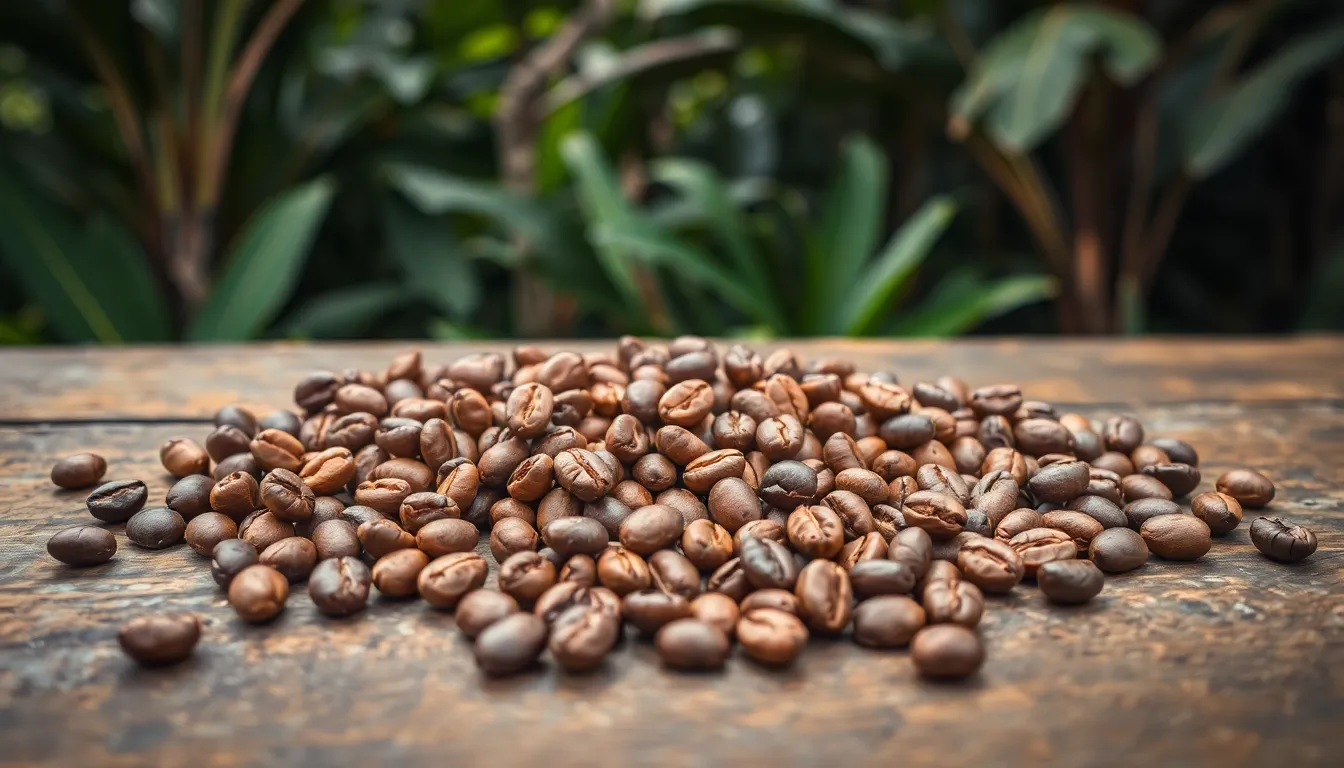
We’ve covered the major coffee varieties, but there’s one more species that deserves recognition even though its rarity. Excelsa coffee beans represent the enigmatic fourth member of the coffee family, often classified as a hybrid between Liberica and Arabica or Robusta varieties.
Complex Tart and Fruity Taste Profile
Excelsa coffee delivers a balanced and multidimensional flavor experience that sets it apart from other coffee species. Tropical fruit notes dominate the initial taste, creating a bright and vibrant opening that immediately captures your attention. Warm nuts provide the middle notes, adding depth and richness to the overall profile.
Subtle wood undertones emerge as the coffee develops on your palate, creating an earthy foundation that complements the brighter fruit flavors. Tannic astringency adds complexity similar to what we find in fine wines, giving Excelsa its distinctive character.
Moderate acidity balances perfectly with the coffee’s natural bitterness, while the full body ensures a satisfying mouthfeel that lingers pleasantly. This combination creates what many describe as one of the most complex taste profiles in the coffee industry.
Blending Applications in Coffee Mixtures
Excelsa’s unique flavor characteristics make it particularly valuable for coffee blending applications. Coffee roasters use Excelsa beans to add depth and complexity to their signature blends, taking advantage of the species’ distinctive fruit and nut notes.
Commercial blends benefit from Excelsa’s ability to enhance rather than overpower other coffee flavors in the mixture. But, the rarity of Excelsa beans significantly limits their widespread use in mass market coffee products.
Specialty coffee shops occasionally feature Excelsa in limited edition blends, where its unique profile can command premium pricing even though supply constraints.
Cultivation Challenges and Rarity
Excelsa plants present important cultivation challenges that contribute to their extreme rarity in global coffee markets. Tree height reaches up to 20 meters, making these arboreal plants difficult to harvest compared to more manageable coffee varieties.
Altitude requirements are exact and demanding, with Excelsa thriving only between 1,000 and 1,300 meters above sea level. Temperature stability and high humidity are essential environmental factors that limit suitable growing regions worldwide.
Deep root systems allow Excelsa plants to survive in arid conditions, demonstrating remarkable resilience even though their challenging management requirements. But, these same characteristics make commercial cultivation economically difficult.
Global production accounts for only about 1% of all coffee beans, with primary cultivation occurring in Chad and Vietnam. This extreme rarity ensures that Excelsa remains a specialty product accessible mainly to dedicated coffee enthusiasts and collectors.
Single-Origin Coffee Beans: Terroir-Driven Flavor Experiences
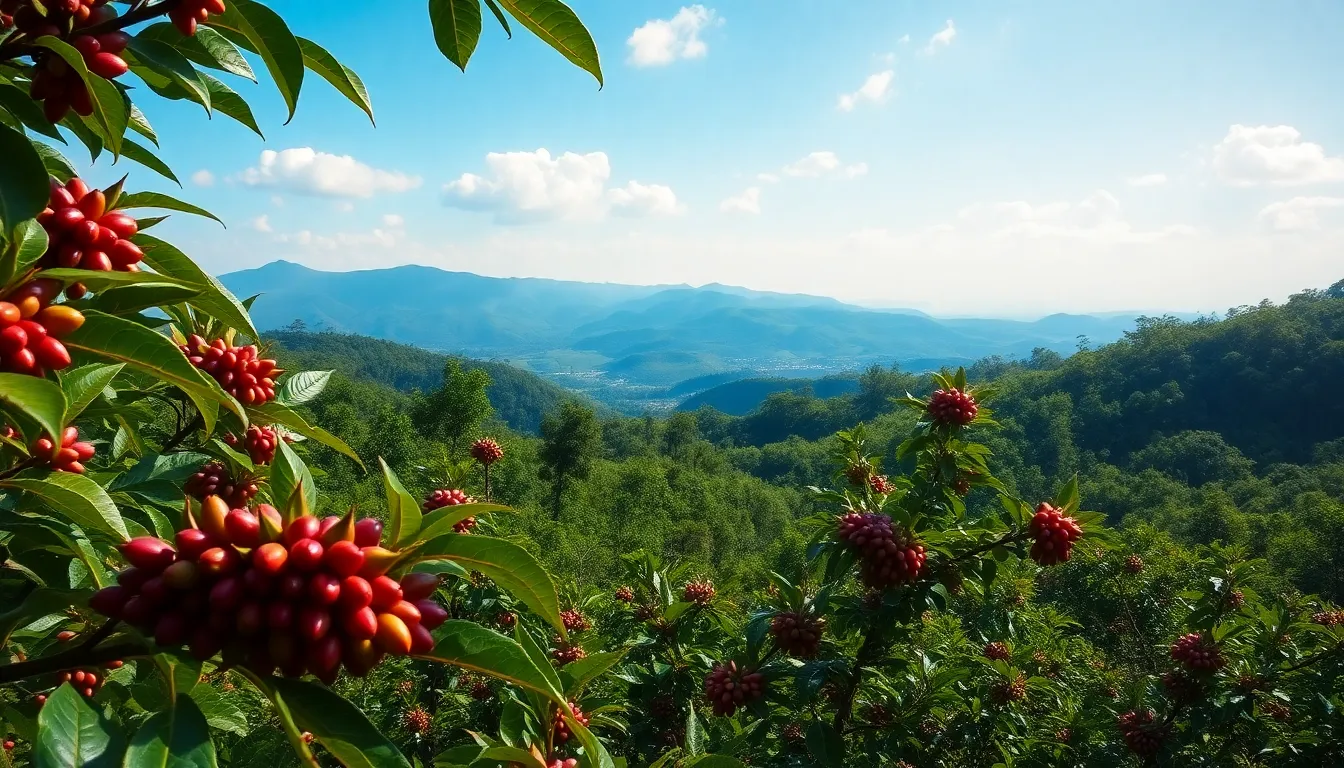
Single-origin coffee beans showcase the pure essence of one exact location, offering coffee enthusiasts a direct connection to the unique characteristics of that particular region. These beans capture the distinct terroir—the environmental factors that influence flavor development during cultivation.
Geographic Influence on Bean Characteristics
Climate plays a crucial role in developing the complex flavor profiles we associate with premium single-origin coffees. Cooler climates and higher altitudes create slower maturation periods, allowing beans to develop more intricate taste characteristics that distinguish them from standard commercial varieties.
Soil composition directly impacts the mineral notes present in each cup of single-origin coffee. Different soil types impart unique flavor signatures, from volcanic soils that contribute earthy undertones to limestone-rich grounds that enhance bright acidity levels.
Cultivation practices shape the final flavor profile through methods like organic farming and shade-grown techniques. These farming approaches affect both the bean’s aroma development and overall taste complexity, creating the distinct characteristics that single-origin enthusiasts seek.
Premium Pricing and Quality Standards
Single-origin coffees command higher prices due to their unique characteristics and the stringent quality control required to maintain consistency. The difficulty in sourcing beans from a single location while ensuring premium quality justifies the elevated cost structure.
Quality standards for single-origin beans focus on recent harvesting dates and precise processing methods. These factors ensure that the terroir-driven flavors remain intact from farm to cup, maintaining the authentic taste profile that defines each origin.
Processing methods must be carefully controlled to preserve the distinct characteristics that make single-origin coffees valuable. Roasters and suppliers carry out strict quality measures to ensure that the unique terroir elements aren’t compromised during handling and preparation.
Popular Single-Origin Regions
Colombia produces single-origin beans known for their balanced acidity and distinctive caramel sweetness. The country’s diverse microclimates create varying flavor profiles within different growing regions, offering coffee lovers multiple taste experiences from a single origin.
Ethiopia delivers fruity and floral notes with bright acidity levels that reflect the birthplace of coffee cultivation. Ethiopian single-origin beans often showcase complex flavor profiles that include wine-like characteristics and distinctive aromatic qualities.
Brazil offers mild-flavored single-origin options with low acidity levels, even though being primarily known for blend components. Brazilian single-origin beans provide smooth, approachable flavors that appeal to both new and experienced coffee drinkers.
Kenya produces single-origin beans renowned for their bright acidity and complex flavor profiles featuring blackcurrant and citrus notes. Kenyan beans deliver bold, wine-like characteristics that make them highly sought after by specialty coffee enthusiasts seeking distinctive taste experiences.
Blended Coffee Beans: Balanced Flavor Combinations
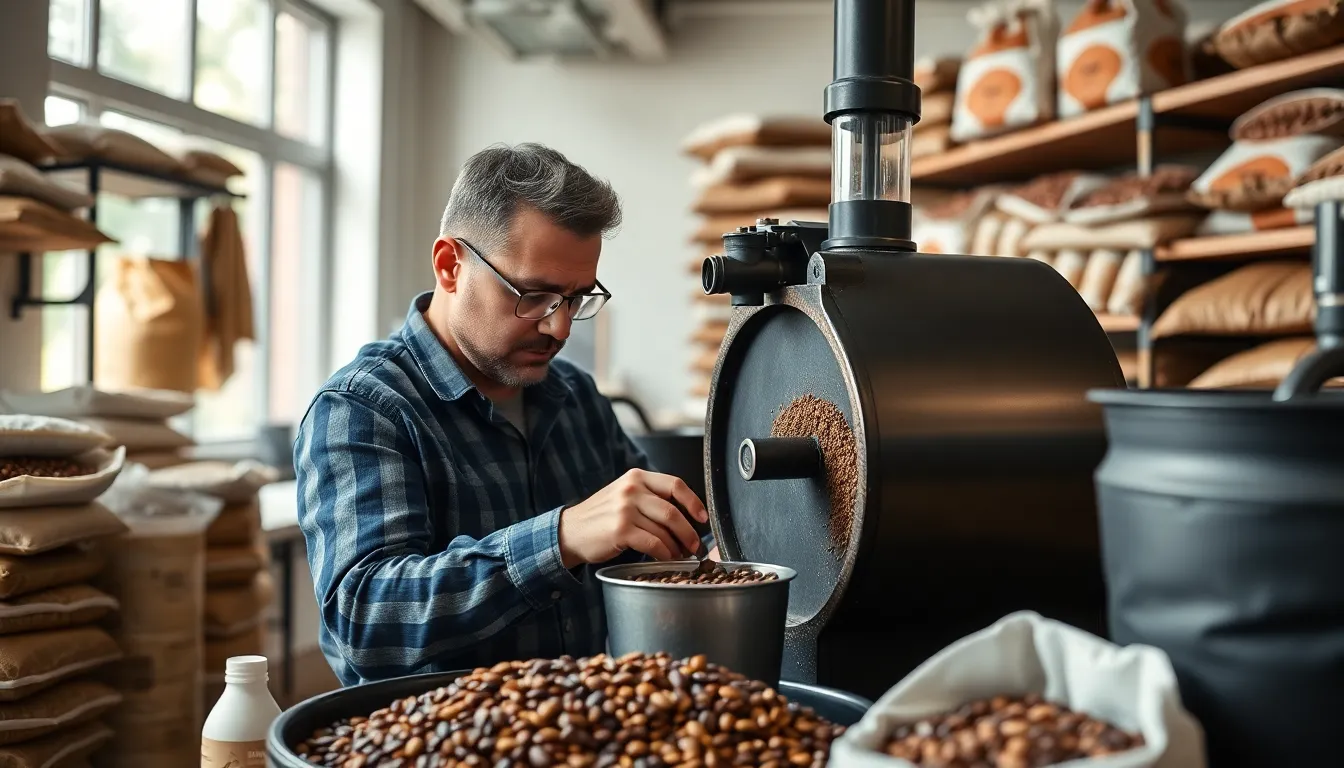
Blended coffee beans combine two or more bean types to create more complex and balanced flavor profiles than single varieties can achieve alone. Most blends feature Arabica and Robusta beans, leveraging Arabica’s mild aromatic qualities with Robusta’s bold characteristics for well-rounded cups.
Art of Coffee Bean Blending
Crafting exceptional blends requires roasters to highlight the best attributes of each bean type through careful experimentation. Master blenders test different ratios and roast levels to create signature profiles that deliver smoothness, body, and consistent flavor experiences across batches.
Precision becomes essential when combining beans with varying densities, moisture levels, and flavor compounds. Roasters often blend beans after roasting rather than before to maintain control over each component’s development. Complex blends might feature three or four different origins, with each contributing exact characteristics like brightness from Ethiopian beans, earthiness from Sumatran varieties, or chocolate notes from Brazilian coffees.
Consistency in Commercial Products
Commercial coffee producers rely on blending to ensure product consistency throughout the year, compensating for natural variations in single-origin harvests. Weather patterns, soil conditions, and seasonal changes affect individual farm outputs, making it challenging to maintain uniform flavor profiles without blending techniques.
Blends smooth out differences in acidity, bitterness, and aroma, ensuring each batch tastes familiar to consumers who expect consistency from their favorite brands. Quality control teams analyze incoming green beans and adjust blend ratios accordingly, sometimes incorporating coffees from multiple harvest seasons to maintain flavor standards.
Major coffee companies often maintain proprietary blending formulas that remain unchanged for decades, creating brand loyalty through reliable taste experiences. These established blends undergo continuous testing and minor adjustments to account for changing supply sources while preserving the original flavor signature.
Cost-Effective Options for Consumers
Blends provide cost-effective alternatives to specialty single-origin coffees by combining beans from multiple sources at different price points. Roasters can incorporate premium Arabica beans with more affordable Robusta varieties, delivering pleasing flavor profiles while keeping prices accessible to broader markets.
Budget-conscious consumers benefit from blends that offer complexity without premium pricing, making quality coffee experiences available to more households. Strategic blending allows roasters to use expensive specialty beans as flavor accents rather than primary components, stretching high-quality ingredients across larger volumes.
Seasonal price fluctuations affect single-origin coffees more dramatically than blends, which can substitute components when certain origins become expensive or unavailable. This flexibility helps maintain stable retail prices while ensuring consistent quality standards for everyday coffee drinkers.
Specialty Coffee Beans: Artisanal and High-Grade Selections
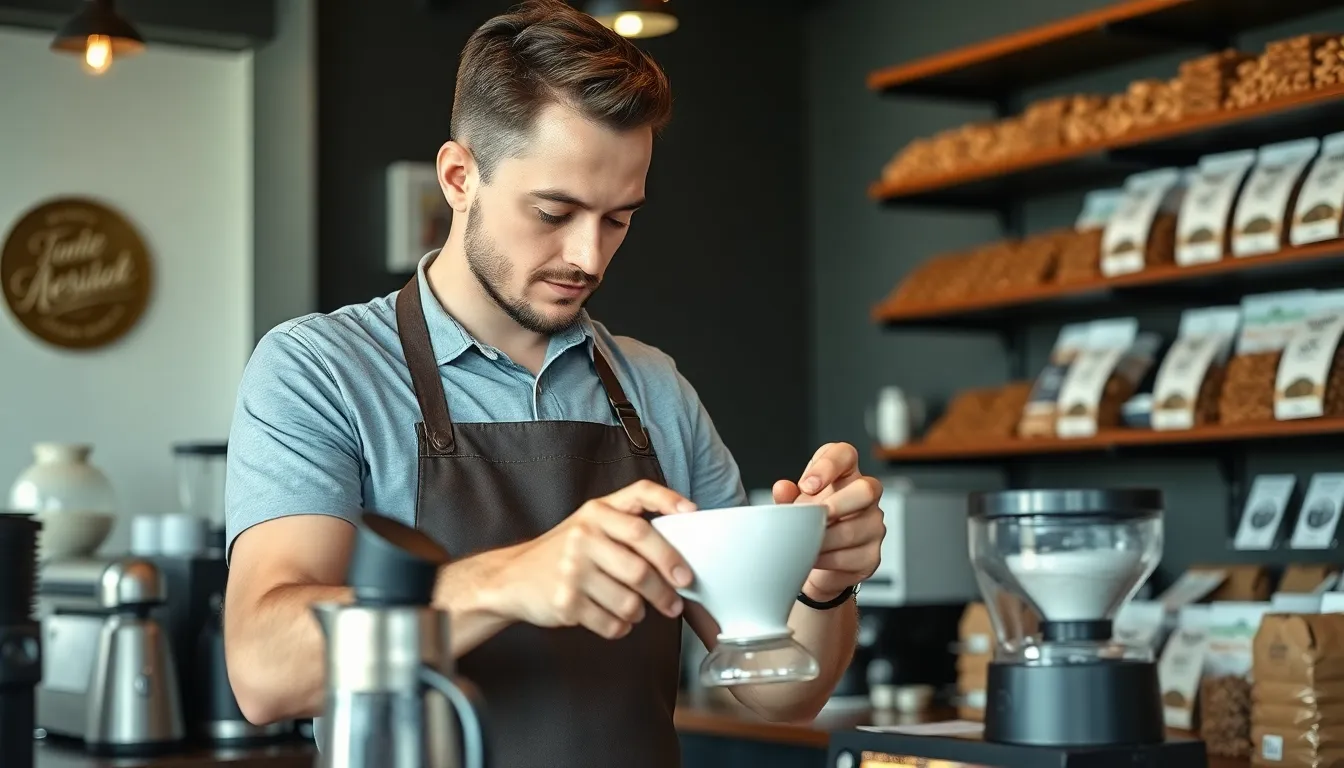
Specialty coffee beans represent the pinnacle of coffee craftsmanship, where high-grade Arabica beans undergo meticulous selection and processing to emphasize their unique flavor profiles. These exceptional beans are often sourced from exact regions and showcase distinct taste characteristics that set them apart from commercial coffee offerings.
Third-Wave Coffee Movement Impact
Third-wave coffee culture has revolutionized how we approach specialty beans by treating coffee as an artisanal create rather than a commodity. This movement emphasizes high-quality, artisanal coffee beans that are often sourced directly from farmers, creating transparency throughout the supply chain. Roasters within this movement focus on improving the flavor characteristics of beans through careful processing and roasting techniques that preserve each bean’s unique terroir. Coffee professionals now treat specialty beans with the same reverence that sommeliers show toward fine wines, highlighting the distinct flavor notes and origin stories of each harvest.
Specialty coffee shops showcase these artisanal beans through precise brewing methods like pour-over, cold brew, and espresso that allow the complex flavors to shine. Baristas receive extensive training to extract the optimal characteristics from each specialty bean, ensuring that customers experience the full range of flavors that careful cultivation and processing can achieve. The movement has educated consumers to appreciate subtle differences between regions, processing methods, and roast profiles, creating demand for higher-quality beans and supporting sustainable farming practices.
Processing Methods and Quality Control
Processing methods play a crucial role in determining the final quality and flavor profile of specialty coffee beans, with washed, natural, and honey processes each contributing distinct characteristics. Washed processing involves removing the cherry pulp before drying, resulting in cleaner, brighter flavors that highlight the bean’s inherent characteristics. Natural processing allows beans to dry inside the fruit, creating more complex, fruity flavors with enhanced sweetness and body.
Honey processing combines elements of both methods by removing some pulp while leaving mucilage attached during drying, producing balanced flavors with moderate sweetness and complexity. Quality control measures ensure that specialty beans meet rigorous standards for taste and quality, including visual inspection for defects, moisture content testing, and cupping evaluations. Specialty coffee organizations like the Specialty Coffee Association have established grading systems that score beans on factors such as aroma, flavor, acidity, body, and overall balance.
Temperature and humidity control during processing and storage preserve the beans’ optimal characteristics, while regular quality assessments ensure consistency across batches. Roasters carry out additional quality control measures by monitoring roast profiles, tracking development times, and conducting taste tests to maintain the high standards that specialty coffee consumers expect.
Direct Trade and Fair Trade Options
Direct trade relationships allow roasters to buy specialty beans directly from farmers, which improves both quality and price fairness for producers and consumers alike. This approach eliminates intermediaries, ensuring that farmers receive higher prices for their premium beans while roasters gain access to exceptional quality coffee with full traceability. Direct trade partnerships often involve long-term commitments that provide farmers with financial stability and incentives to invest in quality improvements and sustainable farming practices.
Fair trade certification ensures that specialty coffee farmers receive fair prices for their products while promoting ethical trade practices throughout the supply chain. Fair trade premiums support community development projects such as education, healthcare, and infrastructure improvements in coffee-growing regions. These certifications require adherence to environmental standards that protect local ecosystems and promote sustainable farming methods that preserve soil health and biodiversity.
Specialty coffee roasters increasingly offer both direct trade and fair trade options to conscious consumers who want to support ethical sourcing practices. Transparency in sourcing allows coffee lovers to understand exactly where their beans come from and how their purchases impact farming communities, creating a meaningful connection between consumers and producers that extends beyond the coffee cup.
Conclusion
We’ve explored the intriguing area of coffee beans from the premium Arabica to the bold Robusta the exotic Liberica and the rare Excelsa varieties. Each type brings its own personality to your cup creating endless possibilities for discovery.
Whether you’re drawn to the transparency of single-origin coffees or the balanced complexity of expertly crafted blends there’s a perfect bean waiting for your taste buds. The specialty coffee movement continues to elevate our appreciation for quality and craftsmanship.
Armed with this knowledge you’re ready to make informed choices that match your preferences and brewing style. Your next great cup of coffee is just a bean selection away.
Frequently Asked Questions
What is the difference between Arabica and Robusta coffee beans?
Arabica beans offer a smoother, more complex flavor with higher sugar content and lower caffeine levels, accounting for 60-70% of global production. Robusta beans have a bolder, more bitter taste with nearly double the caffeine content, making them ideal for espresso blends and those seeking an energy boost.
What are Liberica coffee beans and how do they taste?
Liberica beans are rare, exotic coffee beans with a distinctive teardrop shape and characteristic “hook.” They offer a bold, full-bodied flavor profile with smoky, woody, and fruity notes reminiscent of jackfruit. These beans are primarily cultivated in Southeast Asia and represent a niche product for adventurous coffee drinkers.
What makes single-origin coffee beans special?
Single-origin coffee beans showcase the pure essence of specific locations, offering unique characteristics influenced by climate, soil composition, and cultivation practices. They command higher prices due to their distinctive terroir-driven flavors and stringent quality standards that preserve the authentic taste from farm to cup.
Why do coffee producers create blended coffee beans?
Blended coffee beans combine two or more bean types to create complex, balanced flavor profiles and ensure consistent taste throughout the year. Blends help smooth out natural variations in single-origin harvests while providing cost-effective quality coffee experiences by combining beans from various sources at different price points.
What defines specialty coffee beans?
Specialty coffee beans represent the pinnacle of coffee craftsmanship, featuring high-grade Arabica beans that undergo meticulous selection and processing. They emphasize unique flavor profiles through careful attention to processing methods, direct trade practices, and artisanal roasting techniques that treat coffee as an artisanal creation rather than a commodity.
How do processing methods affect coffee bean flavor?
Processing methods significantly impact the final quality and flavor profile of coffee beans. Washed processing creates clean, bright flavors; natural processing adds fruity, wine-like notes; and honey processing provides balanced sweetness with body. Each method contributes distinct characteristics that influence the overall taste experience.
What is Excelsa coffee and why is it rare?
Excelsa coffee is a hybrid variety delivering complex flavors with tropical fruit notes, warm nutty middle tones, and subtle wood undertones. It accounts for only 1% of global coffee production due to significant cultivation challenges and lower yields, making it a specialty product accessible primarily to dedicated coffee enthusiasts.
